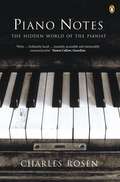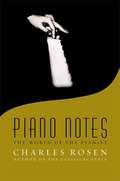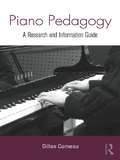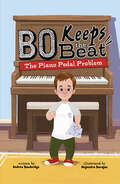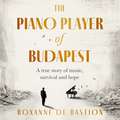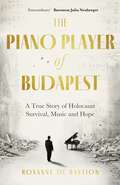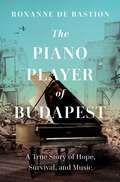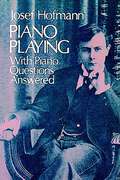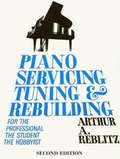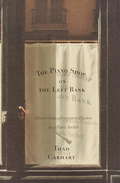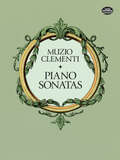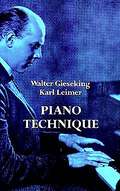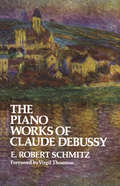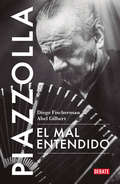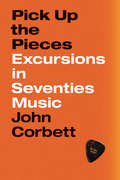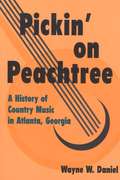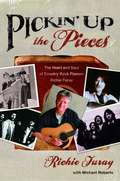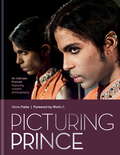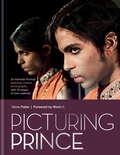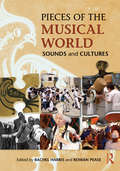- Table View
- List View
Piano Notes: The Hidden World of the Pianist
by Charles RosenIn this eloquent, intimate exploration of the delights and demands of the piano, world-renowned concert pianist and music writer Charles Rosen draws on a lifetime's wisdom to consider every aspect of the instrument: from what makes a beautiful sound to suffering from stage fright, from the physical challenges of playing to tales of great musicians, including Vladimir Horowitz's recording tricks, Rachmaninov's hands and why Artur Rubenstein applied hairspray to the keys. Gracefully blending anecdote, history, expertise and memoir, Piano Notes will enchant anyone with a passion for music.
Piano Notes: The World of the Pianist
by Charles RosenCharles Rosen is one of the world's most talented pianists -- and one of music's most astute commentators. Known as a performer of Bach, Beethoven, Stravinsky, and Elliott Carter, he has also written highly acclaimed criticism for sophisticated students and professionals. In Piano Notes, he writes for a broader audience about an old friend -- the piano itself. Drawing upon a lifetime of wisdom and the accumulated lore of many great performers of the past, Rosen shows why the instrument demands such a stark combination of mental and physical prowess. Readers will gather many little-known insights -- from how pianists vary their posture, to how splicings and microphone placements can ruin recordings, to how the history of composition was dominated by the piano for two centuries. Stories of many great musicians abound. Rosen reveals Nadia Boulanger's favorite way to avoid commenting on the performances of her friends ("You know what I think," spoken with utmost earnestness), why Glenn Gould's recordings suffer from "double-strike" touches, and how even Vladimir Horowitz became enamored of splicing multiple performances into a single recording. Rosen's explanation of the piano's physical pleasures, demands, and discontents will delight and instruct anyone who has ever sat at a keyboard, as well as everyone who loves to listen to the instrument. In the end, he strikes a contemplative note. Western music was built around the piano from the classical era until recently, and for a good part of that time the instrument was an essential acquisition for every middle-class household. Music making was part of the fabric of social life. Yet those days have ended. Fewer people learn the instrument today. The rise of recorded music has homogenized performance styles and greatly reduced the frequency of public concerts. Music will undoubtedly survive, but will the supremely physical experience of playing the piano ever be the same?
Piano Pedagogy: A Research and Information Guide (Routledge Music Bibliographies)
by Gilles ComeauPiano Pedagogy: A Research and Information Guide provides a detailed outline of resources available for research and/or training in piano pedagogy. Like its companion volumes in the Routledge Music Bibliographies series, it serves beginning and advanced students and scholars as a basic guide to current research in the field. The book will includes bibliographies, research guides, encyclopedias, works from other disciplines that are related to piano pedagogy, current sources spanning all formats, including books, journals, audio and video recordings, and electronic sources.
The Piano Pedal Problem (Bo Keeps the Beat)
by Andrew BambridgeBo really wants to take piano lessons like his older brother Jason. But there are two problems—his mom says he’s not ready, and his feet can’t reach the foot pedals because of his achondroplasia. But Bo knows that where there’s a problem, there’s a solution! With determination and the help of a kind teacher, Bo tackles the piano problem, and his feet and fingers finally feel the music! Musician, educator, and actor Andrew Bambridge (Pixels) offers a charming chapter book series about a boy named Bo who, like Andrew, has achondroplasia and has always loved music.
The Piano Player of Budapest: A True Story of Holocaust Survival, Music and Hope
by Roxanne de BastionOne man, his piano and their miraculous survival.'Extraordinary' Baroness Julia Neuberger'Stunning. A beautiful blend of action, poetry, thought-provoking comment and music ... just brilliant' James Ainscough OBE'A gripping narrative of suffering, loss and survival, with music at its heart' Fiona MaddocksAll future, freedom and success lay ahead of young pianist Stephen de Bastion in 1930s Hungary. Life whirled headily around cocktails, romance, applause and the buzz of Budapest late into the night. Then, 1939. Stephen's world disintegrates and this becomes a story of his brutal descent, of his time in labour camps, of Mauthausen and Gunskirchen and the unimaginable horrors he endured during the Holocaust as a man of Jewish descent. Yet, this is also a tale of extraordinary escape ... and the piano, waiting for him.The same piano that Roxanne de Bastion, his granddaughter, inherits when her father dies. It has been in the family over one hundred years but it is only when, deep in grief, she discovers a cassette recording of Stephen, that the astonishing history of the piano, the man and her family begins to unravel. Weaving together his original recordings, unpublished memoirs, letters and documents, Roxanne sings out her grandfather's story of music and hope, lost and found. Luminous and profoundly moving, this book captures the great spirit of one man in the face of darkness and the hope that echoes down through generations.
The Piano Player of Budapest: A True Story of Holocaust Survival, Music and Hope
by Roxanne de BastionOne man, his piano and their miraculous survival.'Extraordinary' Baroness Julia Neuberger'Stunning. A beautiful blend of action, poetry, thought-provoking comment and music ... just brilliant' James Ainscough OBE'A gripping narrative of suffering, loss and survival, with music at its heart' Fiona MaddocksAll future, freedom and success lay ahead of young pianist Stephen de Bastion in 1930s Hungary. Life whirled headily around cocktails, romance, applause and the buzz of Budapest late into the night. Then, 1939. Stephen's world disintegrates and this becomes a story of his brutal descent, of his time in labour camps, of Mauthausen and Gunskirchen and the unimaginable horrors he endured during the Holocaust as a man of Jewish descent. Yet, this is also a tale of extraordinary escape ... and the piano, waiting for him.The same piano that Roxanne de Bastion, his granddaughter, inherits when her father dies. It has been in the family over one hundred years but it is only when, deep in grief, she discovers a cassette recording of Stephen, that the astonishing history of the piano, the man and her family begins to unravel. Weaving together his original recordings, unpublished memoirs, letters and documents, Roxanne sings out her grandfather's story of music and hope, lost and found. Luminous and profoundly moving, this book captures the great spirit of one man in the face of darkness and the hope that echoes down through generations.
The Piano Player of Budapest: A True Story of Survival, Hope, and Music
by Roxanne de BastionA story about a piano and its most prodigious player—and how they both survived one of the darkest periods in history.When her father died, singer-songwriter Roxanne de Bastion inherited a piano she knew had been in her family for over a hundred years. But it is only when she finds a cassette recording of her grandfather, Stephen, playing one of his compositions, that the true and almost unbelievable history of the piano, this man, and her family begins to unravel. Stephen was a man who enjoyed great fame, a man who suffered the horrors of concentration camps in WWII, a man who ultimately survives—along with his piano. By piecing together his cassette recordings, unpublished memoirs, letters, and documents, Roxanne sings out her grandfather's story of music and hope, lost and found, and explores the power of what can echo down through generations.
Piano Playing: With Piano Questions Answered (Dover Books On Music: Piano #1)
by Josef HofmannJosef Hofmann (1876-1957) was a master of piano technique and an artist who had few equals at the keyboard. A student of Anton Rubinstein and a leading exponent of the works of Chopin, Liszt, and Schumann, he always balanced his virtuoso playing with a firm adherence to the piece as written. It is this balanced approach to piano playing that he advocates in this highly regarded volume on piano technique.The first section of the book contains a discussion of the rules and tricks of correct piano playing: touch, methods of practicing, the use of the pedal, playing the piece as it is written, "How Rubinstein Taught Me to Play," and indispensables in pianistic success. The second, much longer, section contains Hofmann's answers to specific questions sent to him by piano students and amateurs: questions on positions of the body and hand, actions of the wrist and arm, stretching, staccato, legato, precision, fingering, octaves, the pedals, practice, marks and nomenclature, phrasing, rubato, theory, transposing, and much more.Full of important background information that is highly useful to every piano player, this book will set students on the right track in their studies and allow every amateur to measure the level of his commitment and the quality of the instruction he is receiving. For insight into many facets of playing the piano, there is no better guide than Josef Hofmann.
Piano Servicing, Tuning, and Rebuilding: For the Professional, the Student, the Hobbyist
by Arthur A. ReblitzThe second edition of this world famous book puts into clear pictures and language how anyone handy with tools can repair, regulate, maintain, and even completely rebuild a piano.
The Piano Shop on the Left Bank
by Thad CarhartThad Carhart never realized there was a gap in his life until he happened upon Desforges Pianos, a demure little shopfront in his Pairs neighborhood that seemed to want to hide rather than advertise its wares. Like Alice in Wonderland, he found his attempts to gain entry rebuffed at every turn. An accidental introduction finally opened the door to the quartier's oddest hangout, where locals -- from university professors to pipefitters -- gather on Friday evenings to discuss music, love, and life over a glass of wine.Luc, the atelier's master, proves an excellent guide to the history of this most gloriously impractical of instruments. A bewildering variety passes through his restorer's hands: delicate ancient pianofortes, one perhaps the onetime possession of Beethoven. Great hulking beasts of thunderous voice. And the modest piano "with the heart of a lion" that was to become Thad's own.What emerges is a warm and intuitive portrait of the secret Paris -- one closed to all but a knowing few. The Piano Shop on the Left Bank is the perfect book for music lovers, or for anyone who longs to recapture a lost passion.From the Hardcover edition.
Piano Sonatas
by Muzio ClementiTreasury of keyboard music by extremely influential Italian composer includes 10 of his finest sonatas: Sonata in G Minor, Op. 7, No. 3; Sonata in F Minor, Op. 13, No. 6; Sonata in B Minor, Op. 40, No. 2; Sonata in G Minor, Op. 50, No. 3 (Didone Abbandonata); Sonata in D Major, Op. 25, No. 6; Sonata in A Major, Op. 33, No. 1; 4 more. Reprinted from authoritative editions published by C. F. Peters and Kistner & Siegel & Co.
Piano Starts Here: The Young Art Tatum
by Robert Andrew ParkerRegardless of whether they've heard of jazz or Art Tatum, young readers will appreciate how Parker uses simple, lyrical storytelling and colorful and energetic ink-and-wash illustrations to show the world as young Art Tatum might have seen it. Tatum came from modest beginnings and was nearly blind, but his passion for the piano and his acute memory for any sound that he heard drove him to become a virtuoso who was revered by both classical and jazz pianists alike. Included in the back matter is a biography and bibliography.<P><P> Winner of the Schneider Family Book Award
Piano Technique
by Walter Gieseking Karl LeimerThe volume presents two book by Walter Gieseking, foremost pianist of his generation, and his teacher for five years, Karl Leimer, that have long been sought after by students and teachers looking for a radical approach toward developing not only finger-technique but expression-technique. Emphasis throughout is on listening to one's self and proper understanding as the basis of proper technique for the piano.In book one, originally titled The Shortest Way to Pianistic Perfection, Gieseking and Leimer work with a series of piano works -- a study from Lebert and Stark, Bach's Two- and Three-Part Inventions in C, and Beethoven's Sonata in F Minor, Op. 2, No. 1. Before beginning to play, the student is asked to visualize each piece through silent reading. Through Leimer's instruction in this area the student soon discovers how to approach each piece as not merely a series of notes to memorize but as a coherent musical structure to understand. Following are instructions on natural interpretation, with consideration of touch, relaxation, and proper emphasis in the practice. Also given are notes on such topics as etudes, scales, broken chords, the trill, and tranquility.In book two, Rhythmics, Dynamics, Pedal and Other Problems of Piano Playing, Leimer carries his method of visualization further with a study of the Allemande from Bach's French Suite in E Major. Following are further exercises and practices for developing other pianistic technique with reference to works of other composers. Specific exercises which cover rhythmics, dynamics, and phrasing are designed so that they will benefit not only the pianist but also performers on other instruments. Extensive chapters on variety of touch and the pedal give a great number of techniques and exercises for extending the expressive and dynamic range.
Piano Tuning: A Simple and Accurate Method for Amateurs (Dover Books On Music: Piano)
by J. Cree FischerIf you have a note that has dropped in pitch, do you have to call in the tuner? A stuck key? Sympathetic rattle? Missing bridles? A broken hammer shank? An unglued ivory? The answer, in each case, is no: you can make all of these repairs yourself!This is the clearest and most complete book available for beginning tuners and amateur pianists. It explains all the basic processes practically and with model clarity. A non-musician can use this book without too much difficulty.You will learn how upright, grand, and square actions work, and how to take care of the smallest repairs — repairing stuck keys, poorly adjusted bottoms and capstans, crowded back checks, felts and leather on the hammers, hammer stems; softening damper and hammer felts; installing new bridles; eliminating "sympathetic rattle"; all with a minimum of tools and training.You will learn a professional method of tuning based on slightly flattened fifths, where only the octave and the upward fifth intervals are used. This is one of the easiest systems to learn, one capable of a great deal of control, and one perfectly suited to adjusting one or two keys. It is a tested method especially right for amateurs working without a teacher, and a method that trains the ear for other recommended systems. The author also explains "beats," the theory of the tempered scale, and useful experiments you can make with harmonic phenomena.If you want to experiment with tuning a piano, there is no better book to start with. It will help performers and teachers make occasional repairs and learn the structure and scale of the piano. Those who want to know how pianos work will find this book both clear and useful.
The Piano Works of Claude Debussy (Dover Books on Music)
by E. Robert SchmitzThis book is a firsthand report of a great composer's intentions in regard to the performance of his music. These intentions have been digested and interpreted for us by the composer's friend Robert Schmitz (1889–1949), who was himself a distinguished pianist, an articulate musician, and a well-known teacher. The product is an authoritative commentary on the entire body of Debussy's work for piano solo.Written for both performers and listeners, the book's purpose is to increase enjoyment of and insight into these works. The book's shorter opening section comprises notes on many general aspects of the composer's life and work; a biographical sketch; a discussion of Debussy's place in relation to the concepts of impressionism and romanticism; his use of classical forms, tonality and modality, melody, counterpoint, etc. Section two, the heart of the book, examines in detail the whole of Debussy's music for solo piano, two hands. Seventy-one pieces in all are included: The Arabesques, the Suite Bergmasque, the Estampes, Images, Children's Corner, Préludes and Études. Each in its chronological place, the pieces are first described as a whole as to mood, source of programmatic inspiration, structure, tonality, and other characteristics. Then follows specific suggestions dealing with technical and expressive problems of particular measures and phrases.The book is not meant as a substitute for Debussy's piano works; on the contrary, it will cause both listeners and performers to turn to this superb corpus of music with new interest and insight. "Complete, thorough, authoritative and important." — San Francisco Chronicle. "It is a thoughtful and mature reference book and though I am at variance with certain of its premises and conclusions, there is much to provoke the intelligent music lover and the inquiring musician." — Abram Chasins, The New York Times. "There is no doubt that he had closely identified himself with the great French composer, and his love and belief in the music shine through every page of this book." — H. C. Schonbert, The Saturday Review.
Piazzolla. El mal entendido
by Diego Fischerman Abel GilbertPiazzolla. El mal entendido es la biografía definitiva de uno de los compositores de tango más importantes del mundo. La vida y la obra de Astor Piazzolla transcurrieron entre su demonización y el asombrado reconocimiento. Fue el emblema sonoro de una ciudad que buscaba estar a tono con su tiempo y sus aspiraciones. A un siglo de su nacimiento, esta nueva edición de Piazzolla. El mal entendido recupera la trama artística, cultural y política que acompañó al bandoneonista desde su aparición fulgurante junto a Aníbal Troilo hasta su inserción internacional más allá del tango. El ensayo intenta ser un puente crítico de acercamiento a una música que no deja de abrirse a nuevos sentidos y reflexiones. "Este libro siempre ha tratado de ser un puente (uno más) con aquello que nos legó Piazzolla, un modo reflexivo de acercamiento a lo que, primero, llegó como una vibración: el aire de Buenos Aires en movimiento", dicen Fischerman y Gilbert.
Pick Up the Pieces: Excursions in Seventies Music
by John CorbettUnless you lived through the 1970s, it seems impossible to understand it at all. Drug delirium, groovy fashion, religious cults, mega corporations, glitzy glam, hard rock, global unrest—from our 2018 perspective, the seventies are often remembered as a bizarre blur of bohemianism and disco. With Pick Up the Pieces, John Corbett transports us back in time to this thrillingly tumultuous era through a playful exploration of its music. Song by song, album by album, he draws our imaginations back into one of the wildest decades in history. Rock. Disco. Pop. Soul. Jazz. Folk. Funk. The music scene of the 1970s was as varied as it was exhilarating, but the decade’s diversity of sound has never been captured in one book before now. Pick Up the Pieces gives a panoramic view of the era’s music and culture through seventy-eight essays that allow readers to dip in and out of the decade at random or immerse themselves completely in Corbett’s chronological journey. An inviting mix of skilled music criticism and cultural observation, Pick Up the Pieces is also a coming-of-age story, tracking the author’s absorption in music as he grows from age seven to seventeen. Along with entertaining personal observations and stories, Corbett includes little-known insights into musicians from Pink Floyd, Joni Mitchell, James Brown, and Fleetwood Mac to the Residents, Devo, Gal Costa, and Julius Hemphill. A master DJ on the page, Corbett takes us through the curated playlist that is Pick Up the Pieces with captivating melody of language and powerful enthusiasm for the era. This funny, energetic book will have readers longing nostalgically for a decade long past.
Pickin' on Peachtree: A History of Country Music in Atlanta, Georgia (Music in American Life)
by Wayne W. DanielAtlanta played a major role in launching the country music industry in the early 1920s and remained one of the nation’s leading country music centers for four decades. Also a major recording center for twenty years, the city was visited regularly by representatives of New York record companies who traveled south to scout for singers and musicians. During the 1950s, Atlanta’s television stations drew on the talent that had entertained in the area for years to assemble long-running, popular country music shows. Using fresh and fascinating information gleaned from newspaper archives, personal interviews, and other sources, Wayne W. Daniel takes readers from early fiddling conventions through the beginnings of the country music industry, to the early days of country programming on radio, and on through Atlanta’s importance as a regional recording center. He includes an analysis of the role television has played from the 1950s to the present. “If there are still people around who think country music moved right out of the hills directly to Nashville, Wayne Daniel’s book should disabuse them of that. Atlanta was country music’s real birthplace, and has remained a vital and energetic center; Pickin ’ on Peachtree presents a wealth of new information and research, and establishes the importance of Atlanta in the rise of one of America’s most unique art forms.” -- Charles Wolfe, author of Tennessee Strings and Kentucky Country “In this thoroughly researched history of country music in Atlanta, Wayne Daniel explores the major artists, promoters, and industry executives who gave Atlanta’s country music its luster. . . . No one interested in country music, whether in fiddle conventions of the 1910s, the ‘golden age’ of recordings of the 1920s, the early radio barn dance broadcasts of the 1930s and ’40s, or country music on television in the ’50s and beyond will fail to find something of interest in Pickin ’ on Peachtree. -- Norm Cohen, author of Long Steel Rail: The Railroad in American Folksong Wayne w. Daniel is the author of more than 75 articles in Bluegrass Unlimited, Journal of Country Music, Devil’s Box, and other publications.
Pickin' Up the Pieces: The Heart and Soul of Country Rock Pioneer Richie Furay
by Michael Roberts Richie FurayWhen a young Richie Furay moved to New York hoping to make it big in folk music, God wasn't one of his concerns. But destiny was. Later, when he started Buffalo Springfield with Neil Young and Stephen Stills, it seemed Furay's destiny had finally arrived. Although the band recorded only three albums, it remains a touchstone of sixties rock music-with all five band members now enshrined in the Rock and Roll Hall of Fame. Furay remained a musical pioneer, forming Poco and recording some of the first-and best-country rock music of the sixties and seventies. His work was a major influence on the Eagles and innumerable other bands. But he still had not found his destiny. It wasn't until his marriage almost disintegrated that Furay confronted his need for God. After co-founding two legendary bands and recording with a rock super-group, Richie Furay finally found his destiny. The long journey took him from sold-out arena concerts to the pulpit of a Colorado church, from rock royalty to the Rock of Ages.Destiny is often found in the places where we're not looking. As you follow the twists and turns in Richie Furay's inspiring journey, you'll gain fresh insight into your own.From the Trade Paperback edition.
Picturing Prince: An Intimate Portrait
by Steve ParkePICTURING PRINCE sees the late icon's former art director, STEVE PARKE, revealing stunning intimate photographs of the singer from his time working at Paisley Park. At least half of the images in the book are exclusively published here for the first time; most other images in the book are rare to the public eye.Alongside these remarkable images are fifty engaging, poignant and often funny written vignettes by Parke, which reveal the very human man behind the reclusive superstar: from shooting hoops to renting out movie theatres at 4am; from midnight requests for camels to meaningful conversations that shed light on Prince as a man and artist. STEVE PARKE started working with Prince in 1988, after a mutual friend showed Prince some of Steve's photorealistic paintings. He designed everything from album covers and merchandise to sets for Prince's tours and videos. Somewhere in all of this, he became Paisley Park's official art director. He began photographing Prince at the request of the star himself, and continued to do so for the next several years. The images in this book are the arresting result of this collaboration.
Picturing Prince: An Intimate Portrait
by Steve ParkePICTURING PRINCE sees the late icon's former art director, STEVE PARKE, revealing stunning intimate photographs of the singer from his time working at Paisley Park. At least half of the images in the book are exclusively published here for the first time; most other images in the book are rare to the public eye.Alongside these remarkable images are fifty engaging, poignant and often funny written vignettes by Parke, which reveal the very human man behind the reclusive superstar: from shooting hoops to renting out movie theatres at 4am; from midnight requests for camels to meaningful conversations that shed light on Prince as a man and artist. STEVE PARKE started working with Prince in 1988, after a mutual friend showed Prince some of Steve's photorealistic paintings. He designed everything from album covers and merchandise to sets for Prince's tours and videos. Somewhere in all of this, he became Paisley Park's official art director. He began photographing Prince at the request of the star himself, and continued to do so for the next several years. The images in this book are the arresting result of this collaboration.
Picturing Prince: An Intimate Portrait
by Steve ParkePICTURING PRINCE sees the late icon's former art director, STEVE PARKE, revealing stunning intimate photographs of the singer from his time working at Paisley Park. At least half of the images in the book are exclusively published here for the first time; most other images in the book are rare to the public eye.Alongside these remarkable images are fifty engaging, poignant and often funny written vignettes by Parke, which reveal the very human man behind the reclusive superstar: from shooting hoops to renting out movie theatres at 4am; from midnight requests for camels to meaningful conversations that shed light on Prince as a man and artist. STEVE PARKE started working with Prince in 1988, after a mutual friend showed Prince some of Steve's photorealistic paintings. He designed everything from album covers and merchandise to sets for Prince's tours and videos. Somewhere in all of this, he became Paisley Park's official art director. He began photographing Prince at the request of the star himself, and continued to do so for the next several years. The images in this book are the arresting result of this collaboration.
Picturing Prince: An Intimate Portrait
by Steve ParkePICTURING PRINCE sees the late icon's former art director, STEVE PARKE, revealing stunning intimate photographs of the singer from his time working at Paisley Park. At least half of the images in the book are exclusively published here for the first time; most other images in the book are rare to the public eye.Alongside these remarkable images are fifty engaging, poignant and often funny written vignettes by Parke, which reveal the very human man behind the reclusive superstar: from shooting hoops to renting out movie theatres at 4am; from midnight requests for camels to meaningful conversations that shed light on Prince as a man and artist. STEVE PARKE started working with Prince in 1988, after a mutual friend showed Prince some of Steve's photorealistic paintings. He designed everything from album covers and merchandise to sets for Prince's tours and videos. Somewhere in all of this, he became Paisley Park's official art director. He began photographing Prince at the request of the star himself, and continued to do so for the next several years. The images in this book are the arresting result of this collaboration.
Pieces of My Heart: A Life
by Robert J. Wagner Scott EymanThe Hollywood icon tells about his rise to Hollywood stardom among legends like Cary Grant and Barbara Stanwyck and his troubled marriage, divorce, and remarriage to starlet Natalie Wood.In the revelation-filled memoir from one of Hollywood’s most talented actors, readers have a candid and deeply personal look at the life and career of Robert Wagner. Wagner’s long career began in the Hollywood of the 1950s, when studios were dominant and even the love lives of actors were dictated by what benefited the studio. His memoirs will chronicle in a very personal way his rise to stardom, his decline, and his resurrection. Wagner will talk candidly about his famous relationship with Natalie Wood and the circumstances surrounding her tragic death. His friendships and stories include major Hollywood personalities in the last half of the 20th century.When his family moved to Los Angeles, a young Wagner held a variety of jobs (including one as a caddy for Clark Gable) while pursuing his goal, but it was while dining with his parents at a restaurant in Beverly Hills that he was “discovered” by a talent scout.Known as much for his on-screen abilities as his off-screen personal heartbreak, Wagner will discuss for the first time his complicated and ultimately tragic relationship with Hollywood sweetheart Natalie Wood. It was implied that Wagner played a role in Natalie Wood’s tragic drowning off the coast of Catalina Island in 1981 and Wagner, for the first time ever, will set the record straight.With at least two dozen photos to illustrate his real Hollywood-style tell-all, this will be the extremely candid autobiography of Robert Wagner.
Pieces of the Musical World: Sounds and Cultures
by Rachel Harris Rowan PeasePieces of the Musical World: Sounds and Cultures is a fieldwork-based ethnomusicology textbook that introduces a series of musical worlds each through a single "piece." It focuses on a musical sound or object that provides a springboard from which to tell a story about a particular geographic region, introducing key aspects of the cultures in which it is embedded, contexts of performance, the musicians who create or perform it, the journeys it has travelled, and its changing meanings. A collaborative venture by staff and research ethnomusicologists associated with the Department of Music at SOAS, University of London, Pieces of the Musical World is organized thematically. Three broad themes: "Place", "Spirituality" and "Movement" help teachers to connect contemporary issues in ethnomusicology, including soundscape studies, music and the environment, the politics of identity, diaspora and globalization, and music and the body. Each of the book's fourteen chapters highlights a single musical "piece" broadly defined, spanning the range of "traditional," "popular", "classical" and "contemporary" musics, and even sounds which might be considered "not music." Primary sources and a web site hosting recordings with interactive listening guides, a glossary of musical terms and interviews all help to create a unique and dynamic learning experience of our musical world.
